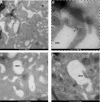Cell Surface Platelet Tissue Factor Expression: Regulation by P2Y12 and Link to Residual Platelet Reactivity
- PMID: 37589138
- PMCID: PMC10521789
- DOI: 10.1161/ATVBAHA.123.319099
Cell Surface Platelet Tissue Factor Expression: Regulation by P2Y12 and Link to Residual Platelet Reactivity
Abstract
Background: ADP-induced platelet activation leads to cell surface expression of several proteins, including TF (tissue factor). The role of ADP receptors in platelet TF modulation is still unknown. We aimed to assess the (1) involvement of P2Y1 and P2Y12 receptors in ADP-induced TF exposure; (2) modulation of TFpos-platelets in anti-P2Y12-treated patients with coronary artery disease. Based on the obtained results, we revisited the intracellular localization of TF in platelets.
Methods: The effects of P2Y1 or P2Y12 antagonists on ADP-induced TF expression and activity were analyzed in vitro by flow cytometry and thrombin generation assay in blood from healthy subjects, P2Y12-/-, and patients with gray platelet syndrome. Ex vivo, P2Y12 inhibition of TF expression by clopidogrel/prasugrel/ticagrelor, assessed by VASP (vasodilator-stimulated phosphoprotein) platelet reactivity index, was investigated in coronary artery disease (n=238). Inhibition of open canalicular system externalization and electron microscopy (TEM) were used for TF localization.
Results: In blood from healthy subjects, stimulated in vitro by ADP, the percentage of TFpos-platelets (17.3±5.5%) was significantly reduced in a concentration-dependent manner by P2Y12 inhibition only (-81.7±9.5% with 100 nM AR-C69931MX). In coronary artery disease, inhibition of P2Y12 is paralleled by reduction of ADP-induced platelet TF expression (VASP platelet reactivity index: 17.9±11%, 20.9±11.3%, 40.3±13%; TFpos-platelets: 10.5±4.8%, 9.8±5.9%, 13.6±6.3%, in prasugrel/ticagrelor/clopidogrel-treated patients, respectively). Despite this, 15% of clopidogrel good responders had a level of TFpos-platelets similar to the poor-responder group. Indeed, a stronger P2Y12 inhibition (130-fold) is required to inhibit TF than VASP. Thus, a VASP platelet reactivity index <20% (as in prasugrel/ticagrelor-treated patients) identifies patients with TFpos-platelets <20% (92% sensitivity). Finally, colchicine impaired in vitro ADP-induced TF expression but not α-granule release, suggesting that TF is open canalicular system stored as confirmed by TEM and platelet analysis of patients with gray platelet syndrome.
Conclusions: Data show that TF expression is regulated by P2Y12 and not P2Y1; P2Y12 antagonists downregulate the percentage of TFpos-platelets. In clopidogrel good-responder patients, assessment of TFpos-platelets highlights those with residual platelet reactivity. TF is stored in open canalicular system, and its membrane exposure upon activation is prevented by colchicine.
Keywords: P2Y12 antagonists; P2Y12 receptor; blood platelets; coronary artery disease; thromboplastin.
Conflict of interest statement
Figures







References
-
- Camera M, Frigerio M, Toschi V, Brambilla M, Rossi F, Cottell DC, Maderna P, Parolari A, Bonzi R, De Vincenti O, et al. . Platelet activation induces cell-surface immunoreactive tissue factor expression, which is modulated differently by antiplatelet drugs. Arterioscler Thromb Vasc Biol. 2003;23:1690–1696. doi: 10.1161/01.ATV.0000085629.23209.AA - PubMed
-
- Mann KG, Brummel K, Butenas S. What is all that thrombin for? J Thromb Haemost. 2003;1:1504–1514. doi: 10.1046/j.1538-7836.2003.00298.x - PubMed
-
- Brummel KE, Paradis SG, Butenas S, Mann KG. Thrombin functions during tissue factor-induced blood coagulation. Blood. 2002;100:148–152. doi: 10.1182/blood.v100.1.148 - PubMed
-
- Falanga A, Marchetti M, Vignoli A, Balducci D, Russo L, Guerini V, Barbui T. V617f jak-2 mutation in patients with essential thrombocythemia: relation to platelet, granulocyte, and plasma hemostatic and inflammatory molecules. Exp Hematol. 2007;35:702–711. doi: 10.1016/j.exphem.2007.01.053 - PubMed
Publication types
MeSH terms
Substances
LinkOut - more resources
Full Text Sources
Medical
Molecular Biology Databases
Research Materials
Miscellaneous

